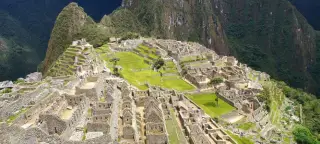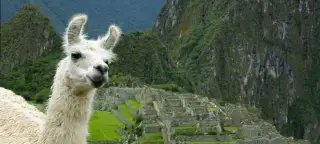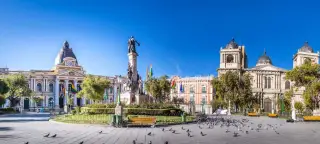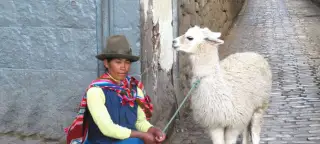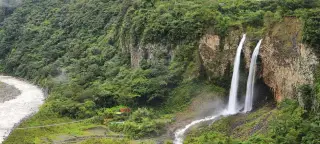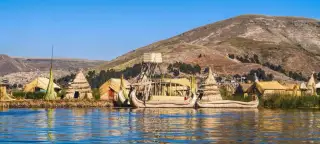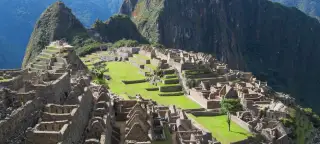Small Group Experiential Travel
Excellent
Attractive destination
4.6
Escape the beaten path
Visit the must-see highlights then discover little-known attractions most tourists never hear about.
All-inclusive comfort
Get more value with all-inclusive trips featuring top-rated restaurants and hotels.
Small Group Size
Typically featuring a modest group of a dozen like-minded travelers, we have a maximum threshold of 16-18 in order to ensure that extra personal attention.
Tour Leaders
Simply the best in the business, our leaders exude professionalism, knowledge, and enthusiasm.
EXPLORE SOUTH AMERICA
10 Tours in Bolivia
10 Day Bolivia Tour
10 Days
Tour Code: BV1
Apr, Oct, Nov
2-Moderate
1 Country
Cultural
Lake Titicaca & Isla del Sol, Tiwanaku Ruins, historic towns, the vast Altiplano and Uyuni salt flats
$3,100/ppUSD
14 Day Peru & Bolivia Tour
14 Days
Tour Code: PE2
Feb, May, Sep
2-Moderate
2 Countries
Cultural
Mysterious Machu Picchu-a must see! ●
Exploring Cuzco and the "Sacred Valley of the Incas" ●
Colourful Chinchero & Pisac markets ●
The Floating Islands of Puno ●
Sacred island of the Sun
$4,450/ppUSD
17 Day Peru & Bolivia Tour
17 Days
Tour Code: PE6
Feb, May, Sep
2-Moderate
2 Countries
Cultural
Scenic Nazca Lines overflight ●
Mysterious Machu Picchu-a must see! ●
Exploring Cuzco and the "Sacred Valley of the Incas" ●
The Floating Islands of Puno ●
Sacred islands of the Sun and Moon
$5,590/ppUSD
Bolivia, Paraguay, Argentina & Uruguay Tour
26 Days
Tour Code: UP2
Apr, Oct, Nov
2-Moderate
4 Countries
Cultural
Stark & dramatic southern Bolivia Altiplano ● Untouristed, charming Paraguay ● Colonial charms of Uruguay ● UNESCO protected Jesuit ruins ● Winery tasting & lunch ● Stunning and varied natural splendours ● Remote, breathtaking Northwest Argentina ● High Andes, coastal scenery, vibrant cities
$9,500/ppUSD
28 Day Peru, Bolivia & Ecuador Tour
28 Days
Tour Code: PQ10
May, Sep
2-Moderate
3 Countries
Cultural
Guided Amazon adventure ●
Famed 'Avenue of Volcanoes' ●
Mysterious Machu Picchu - a must see! ●
Scenic 'Vistadome' train ●
The Floating Islands of Puno ●
Sacred island of the Sun
$9,020/ppUSD
28 Day Ecuador, Peru & Bolivia Tour
28 Days
Tour Code: EP12
Jan
2-Moderate
3 Countries
Cultural
Famed 'Avenue of Volcanoes' ●
Four-night Galapagos cruise ●
Mysterious Machu Picchu - a must see! ●
Scenic 'Vistadome' train ●
The Floating Islands of Puno ●
Sacred island of the Sun
$11,100/ppUSD
31 Day Peru, Bolivia & Ecuador Tour
31 Days
Tour Code: PQ11
May, Sep
2-Moderate
3 Countries
Cultural
Guided Amazon adventure ●
Famed 'Avenue of Volcanoes' ●
Mysterious Machu Picchu - a must see! ●
Scenic 'Vistadome' train ●
The Floating Islands of Puno ●
Sacred island of the Sun
$10,060/ppUSD
32 Day Peru, Bolivia & Ecuador Tour
32 Days
Tour Code: PQ12
May, Sep
2-Moderate
3 Countries
Cultural
Guided Amazon adventure ●
Famed 'Avenue of Volcanoes' ●
Four-night Galapagos cruise ●
Mysterious Machu Picchu - a must see! ●
Scenic 'Vistadome' train ●
The Floating Islands of Puno ●
Sacred island of the Sun
$11,030/ppUSD
32 Day Ecuador, Peru & Bolivia Tour
32 Days
Tour Code: EP13
Jan
2-Moderate
3 Countries
Cultural
Guided Amazon adventure ●
Famed 'Avenue of Volcanoes' ●
Four-night Galapagos cruise ●
Mysterious Machu Picchu - a must see! ●
Scenic 'Vistadome' train ●
The Floating Islands of Puno ●
Sacred island of the Sun
$12,560/ppUSD
Filter By
About Bolivia
Like much of its natural environment, Bolivia is wild in some respects, something we explore on our Bolivia tours. Where other countries, through evolution and development, have lost portions of their ancient roots, Bolivia today retains a stark semblance of the Bolivia that existed in the days of yore and in the times of the great Inca civilization, who once called it home.
Just as the mighty Andes mountains within Bolivia's borders have remained largely unchanged throughout the ages, so too do the culture, traditions and legacies of the Incas yet permeate every aspect of Bolivian life. For cultural exploration and discovery, Bolivia rivals any country on the globe, and this, along with its remarkable landscape, welcoming people and wealth of attractions, makes the country a fantastic atypical tour destination.
Landlocked Bolivia is often overshadowed by the riches of its northern neighbour, Peru, but to underestimate the beauty of Bolivia would be a mistake.
Itâs hard to imagine how people live in the high altiplano regions which most of Bolivia's residents can be found, but people have settled in these high altitude regions for thousands of years. Fertile lands have produced rich foods while llamas and alpacas, distant cousins of the camel, have provided meat and warm wool for people throughout the generations.
Once included within the extent of the Inca Empire, Bolivia is home to another lost tribe, the people of Tiahuanaco. It is believed that their civilization developed over a period of 2,000 years and then mysteriously vanished.
Ancient Inca sites found in Bolivia, ranging from the terraced steps on the Isla del Sol, to the city of Copacabana on the shore of Lake Titicaca. The conquest of the Spanish left a lasting impression on Bolivia, and turbulent history of the lake region can be seen in the many Inca and pre-Inca sites, as well as Spanish colonial churches dotted across the area.
Bolivia provided great riches to the Spanish Empire, especially with the discovery of silver in Cerro Rico, Potosi. It is said the silver discovered in this region helped create phrases such as valer un potosi, "to be worth a potosi" (that is, "a fortune"). At the height of its silver boom, more than eighty six churches were built and the city's population increased to nearly 200,000, making it one of the largest and wealthiest cities in Latin America and in the world.
Other incredible colonial towns visited on Bolivia tours include the university town of Sucre, which includes a large population of indigenous and Quechua speaking peoples today.
While much of Bolivia is located within the lowlands and tropical areas of the Amazon basin, Bolivia tours tend to highlight the exquisite landscapes of the altiplano.
Salar del Uyuni is an area of lunar like qualities. The highest and largest salt lake in the world (10,000 sq km), surrounded by an impressive panorama of unending white. Few oases exist, such as the "Isla Pescado," where you can find unique flora and fauna found at the altitude of over 3650 m (almost 12,000 ft) above sea level.
In the capital, La Paz, the city is flanked by impressive snow capped peaks of the Andes averaging above 5500 m (18,000 ft) including the triple peak of Mount Illimani at 6402 m (20,999 ft).
On Bolivia tours, the scenery, culture and history are the clear focus, however the people and their cuisine naturally becomes a highlight as well. Women wear many layers of petticoats covered by a colourful dress, and over their shoulders they sling a multi-coloured striped blanket called a 'phulla' in which they carry their groceries. Quinoa and llama are diet staples, with tropical fruit juices and cheese breads found at all mealtimes.
One of South America's largest countries, occupying some of its highest landscapes, Bolivia is a country offering incredible highlights to even the seasoned traveller.
Just as the mighty Andes mountains within Bolivia's borders have remained largely unchanged throughout the ages, so too do the culture, traditions and legacies of the Incas yet permeate every aspect of Bolivian life. For cultural exploration and discovery, Bolivia rivals any country on the globe, and this, along with its remarkable landscape, welcoming people and wealth of attractions, makes the country a fantastic atypical tour destination.
Landlocked Bolivia is often overshadowed by the riches of its northern neighbour, Peru, but to underestimate the beauty of Bolivia would be a mistake.
Itâs hard to imagine how people live in the high altiplano regions which most of Bolivia's residents can be found, but people have settled in these high altitude regions for thousands of years. Fertile lands have produced rich foods while llamas and alpacas, distant cousins of the camel, have provided meat and warm wool for people throughout the generations.
Once included within the extent of the Inca Empire, Bolivia is home to another lost tribe, the people of Tiahuanaco. It is believed that their civilization developed over a period of 2,000 years and then mysteriously vanished.
Ancient Inca sites found in Bolivia, ranging from the terraced steps on the Isla del Sol, to the city of Copacabana on the shore of Lake Titicaca. The conquest of the Spanish left a lasting impression on Bolivia, and turbulent history of the lake region can be seen in the many Inca and pre-Inca sites, as well as Spanish colonial churches dotted across the area.
Bolivia provided great riches to the Spanish Empire, especially with the discovery of silver in Cerro Rico, Potosi. It is said the silver discovered in this region helped create phrases such as valer un potosi, "to be worth a potosi" (that is, "a fortune"). At the height of its silver boom, more than eighty six churches were built and the city's population increased to nearly 200,000, making it one of the largest and wealthiest cities in Latin America and in the world.
Other incredible colonial towns visited on Bolivia tours include the university town of Sucre, which includes a large population of indigenous and Quechua speaking peoples today.
While much of Bolivia is located within the lowlands and tropical areas of the Amazon basin, Bolivia tours tend to highlight the exquisite landscapes of the altiplano.
Salar del Uyuni is an area of lunar like qualities. The highest and largest salt lake in the world (10,000 sq km), surrounded by an impressive panorama of unending white. Few oases exist, such as the "Isla Pescado," where you can find unique flora and fauna found at the altitude of over 3650 m (almost 12,000 ft) above sea level.
In the capital, La Paz, the city is flanked by impressive snow capped peaks of the Andes averaging above 5500 m (18,000 ft) including the triple peak of Mount Illimani at 6402 m (20,999 ft).
On Bolivia tours, the scenery, culture and history are the clear focus, however the people and their cuisine naturally becomes a highlight as well. Women wear many layers of petticoats covered by a colourful dress, and over their shoulders they sling a multi-coloured striped blanket called a 'phulla' in which they carry their groceries. Quinoa and llama are diet staples, with tropical fruit juices and cheese breads found at all mealtimes.
One of South America's largest countries, occupying some of its highest landscapes, Bolivia is a country offering incredible highlights to even the seasoned traveller.
Our leaders exude professionalism, knowledge, and enthusiasm.
Tour Leaders for Bolivia Tours


